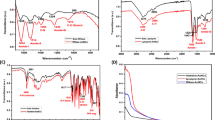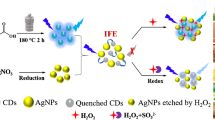Abstract
Cyanazine residue poses a great threat to human health and its derivatives would remain in soils, natural waters, and other environmental domains for a long time. Herein, a simple, rapid, and ultra-sensitive analytical method for the determination of cyanazine (CZ) based on inner filter effect (IFE) of Au nanoparticles (AuNPs) on the fluorescence of CdTe quantum dots (QDs) is first described in this study. With the presence of citrate-stabilized AuNPs, the fluorescence of GSH-capped CdTe QDs was remarkably quenched by AuNPs via IFE. The fluorescence of the AuNP–CdTe QD system was recovered upon addition of CZ. CZ can adsorb on to the surface of AuNPs due to its cyano group that has good affinity with gold, which could induce the aggregation of AuNPs accompanying color change from red to blue. Thus, the IFE of AuNPs on CdTe QDs was weakened, and the fluorescence intensity of CdTe QDs was recovered accordingly. A good linear correlation for detection of CZ was exhibited from 0.05 to 9 μM, and the detection limit reached 0.1568 μM, which was much lower than the safety limit required by the USA, the UK, and China. In order to probe into the selectivity of AuNPs towards CZ over other pesticides, various frequently used pesticides were mixed with AuNPs. AuNP composite solution shows good selectivity towards CZ among other pesticides. This method was successfully carried out for the assessment of CZ in real samples with satisfactory results, which revealed many advantages such as high sensitivity, low cost, and non-time-consuming compared with traditional methods.







Similar content being viewed by others
References
Bao HF, Wang EK, Dong SJ (2006) One-pot synthesis of CdTe nanocrystals and shape control of luminescent CdTe-cystine nanocomposites. Small 2(4):476–480
Brewster JD, Lightfield AR (1993) Rapid biorecognition assay for herbicides in biological matrices. Anal Chem 65(18):2415–2419
Cao XY, Shen F, Zhang MW, Guo JJ, Luo YL, Li X, Liu H, Sun CY, Liu JB (2013) Efficient inner filter effect of gold nanoparticles on the fluorescence of CdS quantum dots for sensitive detection of melamine in raw milk. Food Control 34(1):221–229
Carabias-Martinez R, Rodriguez-Gonzalo E, Dominguez-Alvarez J, Hernandez-Mendez J (2000) Determination of triazine herbicides in natural waters by solid-phase extraction and non-aqueous capillary zone electrophoresis. J Chromatogr A 869(1–2):451–461
Cui X, Liu M, Li BX (2012) Homogeneous fluorescence-based immunoassay via inner filter effect of gold nanoparticles on fluorescence of CdTe quantum dots. Analyst 137(14):3293–3299
Demers LM, Mirkin CA, Mucic RC, Reynolds RA, Letsinger RL (2000) A fluorescence-based method for determining the surface coverage and hybridization efficiency of thiol-capped oligonucleotides bound to gold thin films and nanoparticles. Anal Chem 72(22):5535–5541
Gebel T, Kevekordes S, Pav K, Edenharder R, Dunkelberg H (1997) In vivo genotoxicity of selected herbicides in the mouse bone-marrow micronucleus test. Arch Toxicol 71(3):193–197
Gholivand MB, Torkashyand M, Malekzadeh G (2012) Fabrication of an electrochemical sensor based on computationally designed molecularly imprinted polymers for determination of cyanazine in food samples. Anal Chim Acta 713:36–44
Grabar KC, Freeman RG, Hommer MB, Natan MJ (1995) Preparation and characterization of Au colloid monolayers. Anal Chem 67(4):735–743
Ignjatovic LM, Markovic DA, Veselinovic DS, Besic BR (1993) Polarographic behavior and determination of some S-triazine herbicides. Electroanalysis 5(5–6):529–533
Imene B, Cui ZM, Zhang XY, Gan B, Yin YC, Tian YY, Deng HT, Li HB (2014) 4-Amino-3-mercaptobenzoic acid functionalized gold nanoparticles: synthesis, selective recognition and colorimetric detection of cyhalothrin. Sens Actuators B 199:161–167
Kanagaraj K, Affrose A, Sivakolunthu S, Pitchumani K (2012) Highly selective fluorescent sensing of fenitrothion using per-6-amino-beta-cyclodextrin: Eu(III) complex. Biosens Bioelectron 35(1):452–455
Kuhn S, Baisch B, Jung U, Johannsen T, Kubitschke J, Herges R, Magnussen O (2010) Self-assembly of triazatriangulenium-based functional adlayers on Au(111) surfaces. Phys Chem Chem Phys 12(17):4481–4487
Li HX, Rothberg LJ (2004) Label-free colorimetric detection of specific sequences in genomic DNA amplified by the polymerase chain reaction. J Am Chem Soc 126(35):10958–10961
Li JW, Li XM, Shi XJ, He XW, Wei W, Ma N, Chen H (2013) Highly sensitive detection of caspase-3 activities via a nonconjugated gold nanoparticle-quantum dot pair mediated by an inner-filter effect. ACS Appl Mater Interfaces 5(19):9798–9802
Li Z, Wang Y, Ni YN, Kokot S (2014) Unmodified silver nanoparticles for rapid analysis of the organophosphorus pesticide, dipterex, often found in different waters. Sens Actuators B 193:205–211
Lin CE, Hsueh CC, Wang TZ, Chiu TC, Chen YC (1999) Migration behavior and separation of s-triazines in micellar electrokinetic capillary chromatography using a cationic surfactant. J Chromatogr A 835(1–2):197–207
Lynch SM, Rusiecki JA, Blair A, Dosemeci M, Lubin J, Sandler D, Hoppin JA, Lynch CF, Alavanja MCR (2006) Cancer incidence among pesticide applicators exposed to cyanazine in the agricultural health study. Environ Health Perspect 114(8):1248–1252
Ma YR, Niu HY, Zhang XL, Cai YQ (2011) One-step synthesis of silver/dopamine nanoparticles and visual detection of melamine in raw milk. Analyst 136(20):4192–4196
Pacakova V, Stulik K, Jiskra J (1996) High-performance separations in the determination of triazine herbicides and their residues. J Chromatogr A 754(1–2):17–31
Pedrero M, Alonso MR, Devillena FJM, Pingarron JM (1995) Adsorptive stripping voltammetry in dispersed media—application to the determination of the herbicide terbutryn. Electroanalysis 7(7):644–648
Sabik H, Jeannot R, Rondeau B (2000) Multiresidue methods using solid-phase extraction techniques for monitoring priority pesticides, including triazines and degradation products, in ground and surface waters. J Chromatogr A 885(1–2):217–236
Shaikh AJ, Rabbani F, Sherazi TA, Iqbal Z, Mir S, Shahzad SA (2015) Binding strength of porphyrin-gold nanoparticle hybrids based on number and type of linker moieties and a simple method to calculate inner filter effects of gold nanoparticles using fluorescence spectroscopy. J Phys Chem A 119(7):1108–1116
Shang L, Dong SJ (2009) Design of fluorescent assays for cyanide and hydrogen peroxide based on the inner filter effect of metal nanoparticles. Anal Chem 81(4):1465–1470
Shi HJ, Zhao GH, Liu MC, Fan LF, Cao TC (2013) Aptamer-based colorimetric sensing of acetamiprid in soil samples: sensitivity, selectivity and mechanism. J Hazard Mater 260:754–761
Steegborn C, Skladal P (1997) Construction and characterization of the direct piezoelectric immunosensor for atrazine operating in solution. Biosens Bioelectron 12(1):19–27
Sun JF, Guo L, Bao Y, Xie JW (2011) A simple, label-free AuNPs-based colorimetric ultra sensitive detection of nerve agents and highly toxic organophosphate pesticide. Biosens Bioelectron 28(1):152–157
Tadeo JL, Sanchez-Brunete C, Garcia-Valcarcel AI, Martinez L, Perez RA (1996) Determination of cereal herbicide residues in environmental samples by gas chromatography. J Chromatogr A 754(1–2):347–365
Tan SL, Zhao HY, Tian DM, Wang F, Liu JA, Li HB (2014) Piperidine-calix [4] arene modified gold nanoparticles: imidacloprid colorimetric sensing. Sens Actuators B 204:522–527
Turiel E, Martin-Esteban A, Fernandez P, Perez-Conde C, Camara C (2001) Molecular recognition in a propazine-imprinted polymer and its application to the determination of triazines in environmental samples. Anal Chem 73(21):5133–5141
U.S. EPA (U.S. Environmental Protection Agency) (2004) Federal Insecticide, Fungicide, and Rodenticide Act (FIFRA). http://www.epa.gov/opp00001/regulating/fifra.pdf. Accessed 2 Jan 2005
Xiao N, Yu CX (2010) Rapid-response and highly sensitive noncross-linking colorimetric nitrite sensor using 4-aminothiophenol Modified gold nanorods. Anal Chem 82(9):3659–3663
Xu L, Li BX, Jin Y (2011a) Inner filter effect of gold nanoparticles on the fluorescence of quantum dots and its application to biological aminothiols detection. Talanta 84(2):558–564
Xu Q, Du S, Jin GD, Li HB, Hu XY (2011b) Determination of acetamiprid by a colorimetric method based on the aggregation of gold nanoparticles. Microchim Acta 173(3–4):323–329
Yan X, Li HX, Li Y, Su XG (2014) Visual and fluorescent detection of acetamiprid based on the inner filter effect of gold nanoparticles on ratiometric fluorescence quantum dots. Anal Chim Acta 852:189–195
Yu WW, Qu LH, Guo WZ, Peng XG (2004) Experimental determination of the extinction coefficient of CdTe, CdSe and CdS nanocrystals. Chem Mater 16(3):560 (vol 15, pg 2854, 2003)
Yuan P, Walt DR (1987) Calculation for fluorescence modulation by absorbing species and its application to measurements using optical fibers. Anal Chem 59(19):2391–2394
Zapardiel A, Bermejo E, Perez JA, Chicharro M (2000) Determination of s-triazines with copper and glassy carbon electrodes. Flow injection analysis of aziprotryne in water samples. Fresenius J Anal Chem 367(5):461–466
Zhai YM, Jin LH, Wang P, Dong SJ (2011) Dual-functional Au-Fe3O4 dumbbell nanoparticles for sensitive and selective turn-on fluorescent detection of cyanide based on the inner filter effect. Chem Commun 47(29):8268–8270
Zhang MW, Cao XY, Li HK, Guan FR, Guo JJ, Shen F, Luo YL, Sun CY, Zhang LG (2012) Sensitive fluorescent detection of melamine in raw milk based on the inner filter effect of Au nanoparticles on the fluorescence of CdTe quantum dots. Food Chem 135(3):1894–1900
Zhang XY, Sun ZY, Cui ZM, Li HB (2014) Ionic liquid functionalized gold nanoparticles: synthesis, rapid colorimetric detection of imidacloprid. Sens Actuators B 191:313–319
Zheng JM, Zhang HJ, Qu JC, Zhu Q, Chen XG (2013) Visual detection of glyphosate in environmental water samples using cysteamine-stabilized gold nanoparticles as colorimetric probe. Anal Methods 5(4):917–924
Zhu DR, Li XK, Liu X, Wang JN, Wang ZX (2012) Designing bifunctionalized gold nanoparticle for colorimetric detection of Pb2+ under physiological condition. Biosens Bioelectron 31(1):505–509
Acknowledgments
The present study was supported by the Natural Science Foundation of China (31171684), Key Technologies R&D Program of China (2014BAD07B02) Key Technologies R&D Program of Sichuan Province of China (2013FZ0043), Fundamental Research Funds for the Central Universities (CQDXWL-2013-030), Open fund of Liquor-Making Biotech and Application Key Laboratory of Sichuan Province (NJ2014-03), and Graduate Student Research Innovation Project in Chongqing (CYB14013) Sharing fund of Chongqing university’s large equipment.
Author information
Authors and Affiliations
Corresponding authors
Ethics declarations
Conflict of interest
Liang Dong declares that he has no conflict of interest. Changjun Hou declares that he has no conflict of interest. Huanbao Fa declares that he has no conflict of interest. Mei Yang declares that she has no conflict of interest. Huixiang Wu declares that he has no conflict of interest. Caihong Shen declares that he has no conflict of interest. Danqun Huo declares that she has no conflict of interest.
Ethical approval
This article does not contain any studies with human participants performed by any of the authors.
Electronic supplementary material
Below is the link to the electronic supplementary material.
Rights and permissions
About this article
Cite this article
Dong, L., Hou, C., Yang, M. et al. Highly sensitive colorimetric and fluorescent sensor for cyanazine based on the inner filter effect of gold nanoparticles. J Nanopart Res 18, 164 (2016). https://doi.org/10.1007/s11051-016-3398-x
Received:
Accepted:
Published:
DOI: https://doi.org/10.1007/s11051-016-3398-x




